Kodak AZ901 vs Sony H300
The Kodak PixPro AZ901 and the Sony Cyber-shot DSC-H300 are two digital cameras that were announced, respectively, in January 2016 and February 2014. Both the AZ901 and the H300 are fixed lens compact cameras that are equipped with a 1/2.3-inch sensor. The Kodak has a resolution of 20.2 megapixels, whereas the Sony provides 19.9 MP.
Below is an overview of the main specs of the two cameras as a starting point for the comparison.

Check AZ901 price at
amazon.com

Check H300 offers at
ebay.com
Going beyond this snapshot of core features and characteristics, what are the differences between the Kodak PixPro AZ901 and the Sony Cyber-shot DSC-H300? Which one should you buy? Read on to find out how these two cameras compare with respect to their body size, their imaging sensors, their shooting features, their input-output connections, and their reception by expert reviewers.
Body comparison
The physical size and weight of the Kodak AZ901 and the Sony H300 are illustrated in the side-by-side display below. The two cameras are presented according to their relative size. Three successive views from the front, the top, and the rear are shown. All width, height and depth measures are rounded to the nearest millimeter.
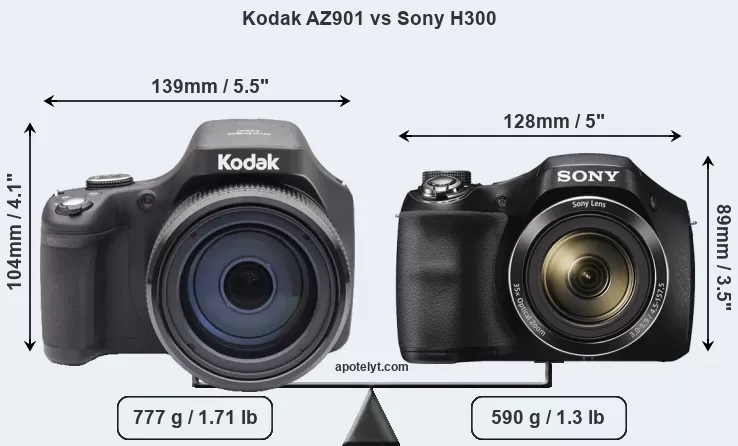
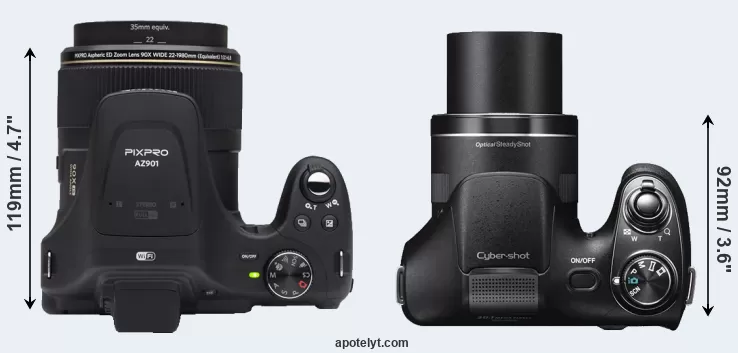
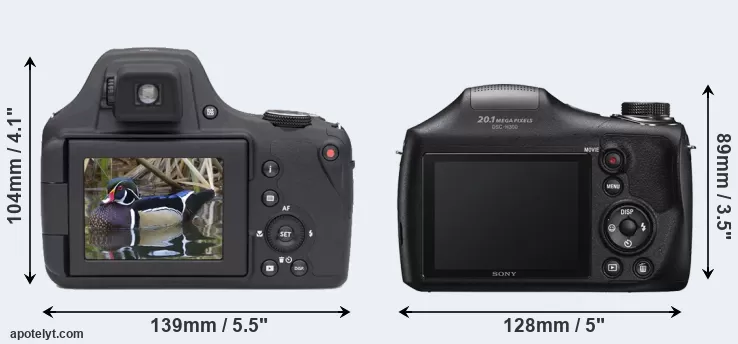
If the front view area (width x height) of the cameras is taken as an aggregate measure of their size, the Sony H300 is notably smaller (21 percent) than the Kodak AZ901. Moreover, the H300 is markedly lighter (24 percent) than the AZ901. In this context, it is worth noting that neither the AZ901 nor the H300 are weather-sealed.
The adjacent table lists the principal physical characteristics of the two cameras alongside a wider set of alternatives. If you would like to visualize and compare a different camera combination, you can navigate to the CAM-parator app and make your selection from a broad list of cameras there.

| Camera Model |
Camera Width |
Camera Height |
Camera Depth |
Camera Weight |
Battery Life |
Weather Sealing |
Camera Launch |
Launch Price (USD) |
Street Price |
||
|---|---|---|---|---|---|---|---|---|---|---|---|
| 1. | Kodak AZ901 | 139 mm | 104 mm | 119 mm | 777 g | 400 | n | Jan 2016 | 499 | amazon.com | |
| 2. | Sony H300 | 128 mm | 89 mm | 92 mm | 590 g | 350 | n | Feb 2014 | 219 | ebay.com | |
| 3. | Canon G9 X | 98 mm | 58 mm | 31 mm | 209 g | 220 | n | Oct 2015 | 529 | ebay.com | |
| 4. | Canon G9 X Mark II | 98 mm | 58 mm | 31 mm | 206 g | 235 | n | Jan 2017 | 529 | ebay.com | |
| 5. | Canon SX610 | 105 mm | 61 mm | 27 mm | 191 g | 270 | n | Jan 2015 | 249 | ebay.com | |
| 6. | Leica Q Typ 116 | 130 mm | 80 mm | 93 mm | 640 g | 300 | n | Jun 2015 | 4,249 | ebay.com | |
| 7. | Nikon B700 | 125 mm | 85 mm | 107 mm | 565 g | 350 | n | Feb 2016 | 499 | ebay.com | |
| 8. | Nikon P900 | 140 mm | 103 mm | 137 mm | 899 g | 360 | n | Mar 2015 | 599 | ebay.com | |
| 9. | Panasonic FZ2500 | 138 mm | 102 mm | 135 mm | 915 g | 350 | n | Sep 2016 | 1,199 | amazon.com | |
| 10. | Panasonic ZS70 | 112 mm | 67 mm | 41 mm | 322 g | 380 | n | Apr 2017 | 449 | ebay.com | |
| 11. | Sony H200 | 123 mm | 83 mm | 87 mm | 530 g | 240 | n | Jan 2013 | 249 | ebay.com | |
| 12. | Sony H400 | 130 mm | 95 mm | 122 mm | 628 g | 300 | n | Feb 2014 | 319 | ebay.com | |
| 13. | Sony HX90V | 102 mm | 58 mm | 36 mm | 245 g | 360 | n | Apr 2015 | 429 | ebay.com | |
| 14. | Sony HX350 | 130 mm | 93 mm | 103 mm | 652 g | 300 | n | Dec 2016 | 449 | ebay.com | |
| 15. | Sony HX400V | 130 mm | 93 mm | 103 mm | 660 g | 300 | n | Feb 2014 | 499 | ebay.com | |
| Note: Measurements and pricing do not include easily detachable parts, such as add-on or interchangeable lenses or optional viewfinders. | |||||||||||
The price is, of course, an important factor in any camera decision. The retail prices at the time of the camera’s release place the model in the market relative to other models in the producer’s line-up and the competition. The H300 was launched at a markedly lower price (by 56 percent) than the AZ901, which puts it into a different market segment. Normally, street prices remain initially close to the MSRP, but after a couple of months, the first discounts appear. Later in the product cycle and, in particular, when the replacement model is about to appear, further discounting and stock clearance sales often push the camera price considerably down.
Sensor comparison
The size of the sensor inside a digital camera is one of the key determinants of image quality. A large sensor will generally have larger individual pixels that offer better low-light sensitivity, provide wider dynamic range, and have richer color-depth than smaller pixels in a sensor of the same technological generation. Further, a large sensor camera will give the photographer additional creative options when using shallow depth-of-field to isolate a subject from its background. On the downside, larger sensors are more costly to manufacture and tend to lead to bigger and heavier cameras and lenses.
Both cameras under consideration feature a 1/2.3-inch sensor and have a format factor (sometimes also referred to as "crop factor") of 5.6. Within the spectrum of camera sensors, this places the review cameras among the smaller-sensor digicams that favor affordability and compact design. Both cameras feature a native aspect ratio (sensor width to sensor height) of 4:3.
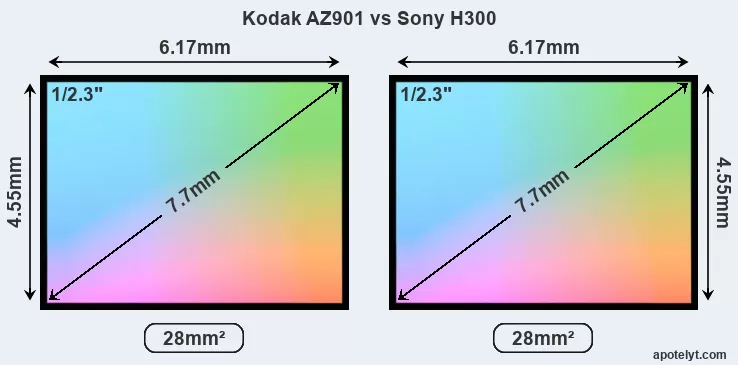
While the two cameras under review share the same sensor size, the AZ901 offers a slightly higher resolution of 20.2 megapixels, compared with 19.9 MP of the H300. This megapixels advantage translates into a 0.59999999999999 percent gain in linear resolution. On the other hand, these sensor specs imply that the AZ901 has a higher pixel density and a smaller size of the individual pixel (with a pixel pitch of 1.18μm versus 1.19μm for the H300). In this context, it should be noted, however, that the AZ901 is a somewhat more recent model (by 1 year and 10 months) than the H300, and its sensor might have benefitted from technological advances during this time that at least partly compensate for the smaller pixel size. Coming back to sensor resolution, it should be mentioned that the H300 has no anti-alias filter installed, so that it can capture all the detail its sensor resolves.
The Kodak PixPro AZ901 has a native sensitivity range from ISO 100 to ISO 3200. The corresponding ISO settings for the Sony Cyber-shot DSC-H300 are ISO 80 to ISO 3200 (no boost).
In terms of underlying technology, the AZ901 is build around a BSI-CMOS sensor, while the H300 uses a CCD imager. Both cameras use a Bayer filter for capturing RGB colors on a square grid of photosensors. This arrangement is found in most digital cameras.
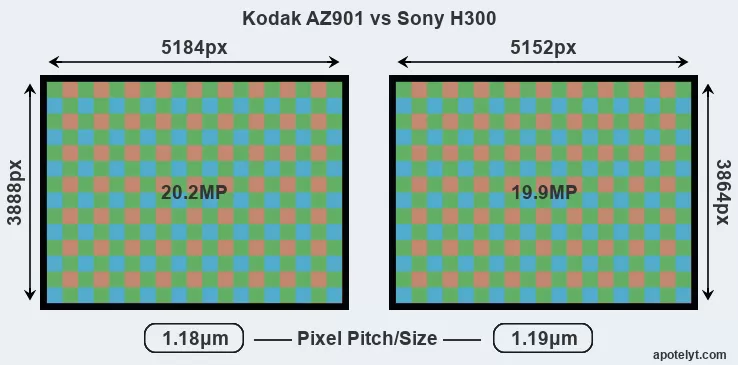
Consistent information on actual sensor performance is available from DXO Mark for many cameras. This service is based on lab testing and assigns an overall score to each camera sensor, as well as ratings for dynamic range ("DXO Landscape"), color depth ("DXO Portrait"), and low-light sensitivity ("DXO Sports"). The following table provides an overview of the physical sensor characteristics, as well as the sensor quality measurements for a selection of comparators.

| Camera Model |
Sensor Class |
Resolution (MP) |
Horiz. Pixels |
Vert. Pixels |
Video Format |
DXO Portrait |
DXO Landscape |
DXO Sports |
DXO Overall |
||
|---|---|---|---|---|---|---|---|---|---|---|---|
| 1. | Kodak AZ901 | 1/2.3 | 20.2 | 5184 | 3888 | 1080/30p | 20.3 | 11.7 | 806 | 48 | |
| 2. | Sony H300 | 1/2.3 | 19.9 | 5152 | 3864 | 720/30p | 20.1 | 11.4 | 630 | 45 | |
| 3. | Canon G9 X | 1-inch | 20.0 | 5472 | 3648 | 1080/60p | 21.5 | 12.3 | 495 | 63 | |
| 4. | Canon G9 X Mark II | 1-inch | 20.0 | 5472 | 3648 | 1080/60p | 21.9 | 12.5 | 522 | 65 | |
| 5. | Canon SX610 | 1/2.3 | 20.2 | 5184 | 3888 | 1080/30p | 20.2 | 11.6 | 712 | 47 | |
| 6. | Leica Q Typ 116 | Full Frame | 24.0 | 6000 | 4000 | 1080/60p | 24.3 | 12.7 | 2221 | 85 | |
| 7. | Nikon B700 | 1/2.3 | 20.2 | 5184 | 3888 | 4K/30p | 20.4 | 11.8 | 818 | 48 | |
| 8. | Nikon P900 | 1/2.3 | 15.9 | 4608 | 3456 | 1080/60p | 20.2 | 11.6 | 727 | 47 | |
| 9. | Panasonic FZ2500 | 1-inch | 20.0 | 5472 | 3648 | 4K/30p | 23.0 | 12.6 | 538 | 70 | |
| 10. | Panasonic ZS70 | 1/2.3 | 20.2 | 5184 | 3888 | 4K/30p | 19.1 | 10.6 | 106 | 36 | |
| 11. | Sony H200 | 1/2.3 | 15.2 | 5184 | 2930 | 720/30p | 19.9 | 11.2 | 529 | 44 | |
| 12. | Sony H400 | 1/2.3 | 19.9 | 5152 | 3864 | 720/30p | 20.1 | 11.4 | 630 | 45 | |
| 13. | Sony HX90V | 1/2.3 | 18.0 | 4896 | 3672 | 1080/60p | 20.2 | 11.6 | 738 | 47 | |
| 14. | Sony HX350 | 1/2.3 | 19.9 | 5152 | 3864 | 1080/60p | 20.5 | 11.9 | 896 | 49 | |
| 15. | Sony HX400V | 1/2.3 | 20.2 | 5184 | 3888 | 1080/60p | 20.1 | 11.4 | 629 | 45 | |
| Note: DXO values in italics represent estimates based on sensor size and age. | |||||||||||
Many modern cameras are not only capable of taking still images, but also of capturing video footage. The two cameras under consideration both have sensors whose read-out speed is fast enough to capture moving pictures, but the AZ901 provides a higher video resolution than the H300. It can shoot video footage at 1080/30p, while the Sony is limited to 720/30p.
Feature comparison
Apart from body and sensor, cameras can and do differ across a variety of features. For example, the AZ901 has an electronic viewfinder (202k dots), which can be very helpful when shooting in bright sunlight. In contrast, the H300 relies on live view and the rear LCD for framing. The following table reports on some other key feature differences and similarities of the Kodak AZ901, the Sony H300, and comparable cameras.

| Camera Model |
Viewfinder (Type or 000 dots) |
Control Panel (yes/no) |
LCD Specifications (inch/000 dots) |
LCD Attach- ment |
Touch Screen (yes/no) |
Max Shutter Speed * |
Max Shutter Flaps * |
Built-in Flash (yes/no) |
Built-in Image Stab |
||
|---|---|---|---|---|---|---|---|---|---|---|---|
| 1. | Kodak AZ901 | 202 | n | 3.0 / 920 | swivel | n | 1/2000s | 5.0/s | Y | Y | |
| 2. | Sony H300 | none | n | 3.0 / 460 | fixed | n | 1/1500s | 0.8/s | Y | Y | |
| 3. | Canon G9 X | none | n | 3.0 / 1040 | fixed | Y | 1/2000s | 6.0/s | Y | Y | |
| 4. | Canon G9 X Mark II | none | n | 3.0 / 1040 | fixed | Y | 1/2000s | 8.2/s | Y | Y | |
| 5. | Canon SX610 | none | n | 3.0 / 922 | fixed | n | 1/2000s | 2.5/s | Y | Y | |
| 6. | Leica Q Typ 116 | 3680 | n | 3.0 / 1040 | fixed | Y | 1/2000s | 10.0/s | n | Y | |
| 7. | Nikon B700 | 921 | n | 3.0 / 921 | swivel | n | 1/4000s | 5.0/s | Y | Y | |
| 8. | Nikon P900 | 921 | n | 3.0 / 921 | swivel | n | 1/4000s | 7.0/s | Y | Y | |
| 9. | Panasonic FZ2500 | 2360 | n | 3.0 / 1040 | swivel | Y | 1/4000s | 12.0/s | Y | Y | |
| 10. | Panasonic ZS70 | 1166 | n | 3.0 / 1040 | tilting | Y | 1/2000s | 10.0/s | Y | Y | |
| 11. | Sony H200 | none | n | 3.0 / 460 | fixed | n | 1/1500s | 0.8/s | Y | Y | |
| 12. | Sony H400 | 210 | n | 3.0 / 460 | fixed | n | 1/2000s | 0.7/s | Y | Y | |
| 13. | Sony HX90V | 638 | n | 3.0 / 921 | tilting | n | 1/2000s | 10.0/s | Y | Y | |
| 14. | Sony HX350 | 202 | n | 3.0 / 922 | tilting | n | 1/4000s | 10.0/s | Y | Y | |
| 15. | Sony HX400V | 210 | n | 3.0 / 921 | tilting | n | 1/4000s | 10.0/s | Y | Y | |
| Note: *) Information refers to the mechanical shutter, unless the camera only has an electronic one. | |||||||||||
Both the AZ901 and the H300 have zoom lenses built in. The AZ901 has a 22-1980mm f/3.1-6.8 optic and the H300 offers a 25-875mm f/3.4-6.5 (focal lengths in full frame equivalent terms). Hence, the Kodak provides a wider angle of view at the short end, as well as more tele-photo reach at the long end than the Sony. The AZ901 offers the faster maximum aperture.
The AZ901 writes its imaging data to SDXC cards, while the H300 uses SDXC or Memory Stick PRO Duo cards.
Connectivity comparison
For some imaging applications, the extent to which a camera can communicate with its environment can be an important aspect in the camera decision process. The table below provides an overview of the connectivity of the Kodak PixPro AZ901 and Sony Cyber-shot DSC-H300 and, in particular, the interfaces the cameras (and selected comparators) provide for accessory control and data transfer.

| Camera Model |
Hotshoe Port |
Internal Mic / Speaker |
Microphone Port |
Headphone Port |
HDMI Port |
USB Port |
WiFi Support |
NFC Support |
Bluetooth Support |
||
|---|---|---|---|---|---|---|---|---|---|---|---|
| 1. | Kodak AZ901 | - | stereo / mono | - | - | micro | 2.0 | Y | - | - | |
| 2. | Sony H300 | - | mono / mono | - | - | micro | 2.0 | Y | - | - | |
| 3. | Canon G9 X | - | stereo / mono | - | - | micro | 2.0 | Y | Y | - | |
| 4. | Canon G9 X Mark II | - | stereo / mono | - | - | micro | 2.0 | Y | Y | Y | |
| 5. | Canon SX610 | - | - / - | - | - | micro | 2.0 | Y | Y | - | |
| 6. | Leica Q Typ 116 | Y | stereo / mono | - | - | micro | 2.0 | Y | Y | - | |
| 7. | Nikon B700 | - | stereo / mono | - | - | micro | 2.0 | Y | Y | Y | |
| 8. | Nikon P900 | - | stereo / mono | - | - | micro | 2.0 | Y | Y | - | |
| 9. | Panasonic FZ2500 | Y | stereo / mono | Y | Y | micro | 2.0 | Y | - | - | |
| 10. | Panasonic ZS70 | - | stereo / mono | - | - | micro | 2.0 | Y | - | - | |
| 11. | Sony H200 | - | mono / mono | - | - | - | 2.0 | - | - | - | |
| 12. | Sony H400 | - | mono / mono | - | - | micro | 2.0 | Y | - | - | |
| 13. | Sony HX90V | - | stereo / mono | - | - | micro | 2.0 | Y | Y | - | |
| 14. | Sony HX350 | - | stereo / mono | - | - | micro | 2.0 | - | - | - | |
| 15. | Sony HX400V | Y | stereo / mono | - | - | micro | 2.0 | Y | Y | - |
The AZ901 is a recent model that features in the current product line-up of Kodak. In contrast, the H300 has been discontinued (but can be found pre-owned on ebay). There has not been a direct replacement model for the H300 from Sony. Further information on the features and operation of the AZ901 and H300 can be found, respectively, in the Kodak AZ901 Manual (free pdf) or the online Sony H300 Manual.
Review summary
So what is the bottom line? Is the Kodak AZ901 better than the Sony H300 or vice versa? Below is a summary of the relative strengths of each of the two contestants.

Arguments in favor of the Kodak PixPro AZ901:
- Better moiré control: Has an anti-alias filter to avoid artificial patterns to appear in images.
- Better video: Provides higher definition movie capture (1080/30p vs 720/30p).
- Easier framing: Has an electronic viewfinder for image composition and settings control.
- More detailed LCD: Has a higher resolution rear screen (920k vs 460k dots).
- More flexible LCD: Has a swivel screen for odd-angle shots in portrait or landscape orientation.
- More selfie-friendly: Has an articulated screen that can be turned to be front-facing.
- Faster shutter: Has higher mechanical shutter speed (1/2000s vs 1/1500s) to freeze action.
- Faster burst: Shoots at higher frequency (5 vs 0.8 flaps/sec) to capture the decisive moment.
- Better light gathering: Has a lens with a wider maximum aperture (f/3.1 vs f/3.4).
- Wider view: Has a wider-angle lens that facilitates landscape or interior shots.
- More tele-reach: Has a longer tele-lens for perspective compression and subject magnification.
- Longer lasting: Can take more shots (400 versus 350) on a single battery charge.
- More modern: Is somewhat more recent (announced 1 year and 10 months after the H300).

Reasons to prefer the Sony Cyber-shot DSC-H300:
- Maximized detail: Lacks an anti-alias filter to exploit the sensor's full resolution potential.
- More compact: Is smaller (128x89mm vs 139x104mm) and will fit more readily into a bag.
- Less heavy: Has a lower weight (by 187g or 24 percent) and is thus easier to take along.
- More affordable: Was introduced into a lower priced category (56 percent cheaper at launch).
- More heavily discounted: Has been on the market for longer (launched in February 2014).
If the number of relative strengths (bullet points above) is taken as a guide, the AZ901 is the clear winner of the match-up (13 : 5 points). However, the relevance of individual strengths will vary across photographers, so that you might want to apply your own weighing scheme to the summary points when reflecting and deciding on a new camera. A professional wildlife photographer will view the differences between cameras in a way that diverges from the perspective of a family photog, and a person interested in architecture has distinct needs from a sports shooter. Hence, the decision which camera is best and worth buying is often a very personal one.
How about other alternatives? Do the specifications of the Kodak AZ901 and the Sony H300 place the cameras among the top in their class? Find out in the latest Best Superzoom Camera listing whether the two cameras rank among the cream of the crop.
In any case, while the specs-based evaluation of cameras can be instructive in revealing their potential as photographic tools, it remains incomplete and does no justice, for example, to the way the AZ901 or the H300 perform in practice. User reviews that are available, for instance, at amazon can sometimes shed light on these issues, but such feedback is all too often partial, inconsistent, and inaccurate.
Expert reviews
This is why expert reviews are important. The adjacent summary-table relays the overall verdicts of several of the most popular camera review sites (amateurphotographer [AP], cameralabs [CL], digitalcameraworld [DCW], dpreview [DPR], ephotozine [EPZ], photographyblog [PB]). As can be seen, the professional reviewers agree in many cases on the quality of different cameras, but sometimes their assessments diverge, reinforcing the earlier point that a camera decision is often a very personal choice.

| Camera Model |
AP score |
CL score |
DCW score |
DPR score |
EPZ score |
PB score |
Camera Launch |
Launch Price (USD) |
Street Price |
||
|---|---|---|---|---|---|---|---|---|---|---|---|
| 1. | Kodak AZ901 | .. | .. | .. | .. | 3.5/5 | 3/5 | Jan 2016 | 499 | amazon.com | |
| 2. | Sony H300 | .. | + | .. | .. | 4.5/5 | 4/5 | Feb 2014 | 219 | ebay.com | |
| 3. | Canon G9 X | 3.5/5 | + + | .. | .. | 4.5/5 | 4.5/5 | Oct 2015 | 529 | ebay.com | |
| 4. | Canon G9 X Mark II | 4/5 | .. | 4/5 | 75/100 | 4.5/5 | 4.5/5 | Jan 2017 | 529 | ebay.com | |
| 5. | Canon SX610 | .. | .. | .. | .. | 4/5 | 4/5 | Jan 2015 | 249 | ebay.com | |
| 6. | Leica Q Typ 116 | 5/5 | .. | .. | 80/100 | 4.5/5 | 4.5/5 | Jun 2015 | 4,249 | ebay.com | |
| 7. | Nikon B700 | .. | + | .. | .. | 4/5 | 4/5 | Feb 2016 | 499 | ebay.com | |
| 8. | Nikon P900 | .. | .. | .. | 77/100 | 4/5 | 4/5 | Mar 2015 | 599 | ebay.com | |
| 9. | Panasonic FZ2500 | .. | + | .. | 82/100 | 4.5/5 | 5/5 | Sep 2016 | 1,199 | amazon.com | |
| 10. | Panasonic ZS70 | .. | + + | .. | .. | 4/5 | 4/5 | Apr 2017 | 449 | ebay.com | |
| 11. | Sony H200 | .. | .. | .. | .. | 3.5/5 | 3.5/5 | Jan 2013 | 249 | ebay.com | |
| 12. | Sony H400 | .. | o | .. | .. | 3.5/5 | 3.5/5 | Feb 2014 | 319 | ebay.com | |
| 13. | Sony HX90V | 4/5 | + + | .. | .. | 4/5 | 4.5/5 | Apr 2015 | 429 | ebay.com | |
| 14. | Sony HX350 | .. | .. | .. | .. | .. | 4/5 | Dec 2016 | 449 | ebay.com | |
| 15. | Sony HX400V | 4/5 | + + | .. | .. | 4/5 | 4/5 | Feb 2014 | 499 | ebay.com | |
| Note: (+ +) highly recommended; (+) recommended; (o) reviewed; (..) not available. | |||||||||||
Care should be taken when interpreting the review scores above, though. The ratings are only valid when referring to cameras in the same category and of the same age. Hence, a score should always be seen in the context of the camera's market launch date and its price, and rating-comparisons among cameras that span long time periods or concern very differently equipped models make little sense. It should also be noted that some of the review sites have over time altered the way they render their verdicts.

Check AZ901 price at
amazon.com

Check H300 offers at
ebay.com
Other camera comparisons
Did this review help to inform your camera decision process? If you would like to see a different side-by-side camera review, just make a corresponding selection in the search boxes below. As an alternative, you can also directly jump to any one of the listed comparisons that were previously generated by the CAM-parator tool.
- Canon 4000D vs Sony H300
- Canon G1 X Mark II vs Sony H300
- Canon R6 vs Kodak AZ901
- Canon RP vs Kodak AZ901
- Canon SX410 vs Kodak AZ901
- Fujifilm GFX 100 vs Sony H300
- Kodak AZ901 vs Leica Digilux 3
- Kodak AZ901 vs Nikon D300
- Kodak AZ901 vs Pentax K-1
- Nikon D5 vs Sony H300
- Nikon P1000 vs Sony H300
- Panasonic G95 vs Sony H300
Specifications: Kodak AZ901 vs Sony H300
Below is a side-by-side comparison of the specs of the two cameras to facilitate a quick review of their differences and common features.
| Camera Model | Kodak AZ901 | Sony H300 |
|---|---|---|
| Camera Type | Fixed lens compact camera | Fixed lens compact camera |
| Camera Lens | 22-1980mm f/3.1-6.8 | 25-875mm f/3.4-6.5 |
| Launch Date | January 2016 | February 2014 |
| Launch Price | USD 499 | USD 219 |
| Sensor Specs | Kodak AZ901 | Sony H300 |
| Sensor Technology | BSI-CMOS | CCD |
| Sensor Format | 1/2.3" Sensor | 1/2.3" Sensor |
| Sensor Size | 6.17 x 4.55 mm | 6.17 x 4.55 mm |
| Sensor Area | 28.0735 mm2 | 28.0735 mm2 |
| Sensor Diagonal | 7.7 mm | 7.7 mm |
| Crop Factor | 5.6x | 5.6x |
| Sensor Resolution | 20.2 Megapixels | 19.9 Megapixels |
| Image Resolution | 5184 x 3888 pixels | 5152 x 3864 pixels |
| Pixel Pitch | 1.18 μm | 1.19 μm |
| Pixel Density | 71.80 MP/cm2 | 70.91 MP/cm2 |
| Moiré control | Anti-Alias filter | no AA filter |
| Movie Capability | 1080/30p Video | 720/30p Video |
| ISO Setting | 100 - 3,200 ISO | 80 - 3,200 ISO |
| Screen Specs | Kodak AZ901 | Sony H300 |
| Viewfinder Type | Electronic viewfinder | no viewfinder |
| Viewfinder Field of View | 100% | |
| Viewfinder Resolution | 202k dots | |
| LCD Framing | Live View | Live View |
| Rear LCD Size | 3.0inch | 3.0inch |
| LCD Resolution | 920k dots | 460k dots |
| LCD Attachment | Swivel screen | Fixed screen |
| Shooting Specs | Kodak AZ901 | Sony H300 |
| Focus System | Contrast-detect AF | Contrast-detect AF |
| Continuous Shooting | 5 shutter flaps/s | 0.8 shutter flaps/s |
| Fill Flash | Built-in Flash | Built-in Flash |
| Storage Medium | SDXC cards | MS or SDXC cards |
| Single or Dual Card Slots | Single card slot | Single card slot |
| UHS card support | no | no |
| Connectivity Specs | Kodak AZ901 | Sony H300 |
| External Flash | no Hotshoe | no Hotshoe |
| USB Connector | USB 2.0 | USB 2.0 |
| HDMI Port | micro HDMI | micro HDMI |
| Wifi Support | Wifi built-in | Wifi built-in |
| Body Specs | Kodak AZ901 | Sony H300 |
| Battery Type | Kodak LB-070 | Sony 4xAA |
| Battery Life (CIPA) | 400 shots per charge | 350 shots per charge |
| Body Dimensions |
139 x 104 x 119 mm (5.5 x 4.1 x 4.7 in) |
128 x 89 x 92 mm (5.0 x 3.5 x 3.6 in) |
| Camera Weight | 777 g (27.4 oz) | 590 g (20.8 oz) |

Check AZ901 price at
amazon.com

Check H300 offers at
ebay.com
Did you notice an error on this page? If so, please get in touch, so that we can correct the information.

